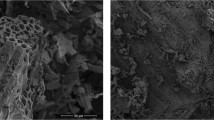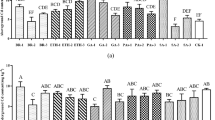Abstract
Although several grasses have been evaluated for cadmium (Cd) phytoextraction, there are few studies assessing how Cd is accumulated and distributed in the tissues of Panicum maximum grown in mildly spiked soils. The evaluation of tillering, nutritional status and biomass yield of this grass, mainly along successive shoot regrowths, is not well studied so far. Thus, P. maximum Jacq. cv. Massai was grown for two periods in an Oxisol presenting bioavailable Cd concentrations varying from 0.04 (control) to 10.91 mg kg−1 soil. Biomass yield of leaves and stems’ growth has decreased under the highest Cd exposure, but it did not occur in the regrowth period, indicating that Cd-induced toxicity is stronger in the early stages of development of P. maximum. The tillering was not compromised even the basal node presenting Cd concentrations higher than 100 mg kg−1 DW. We identified a restriction on Cd transport upwards from basal node, which was the main localization of Cd accumulation. Apparently, P, K, Mg, S and Cu are involved in processes that restrict Cd translocation and confer high tolerance to Cd in P. maximum. The Cd-induced nutritional disorders did not negatively correlate with factors used to calculate phytoextraction efficiency. However, the nutritional adjustments of P. maximum to cope with Cd stress restricted the upward Cd transport, which decreased the phytoextraction efficiency from the available Cd concentration of 5.93 mg kg−1 soil.





Similar content being viewed by others
Availability of Data and Material
Not applicable.
Code Availability
Not applicable.
References
Abreu, C. A., Abreu, M. F., Andrade, J. C., van Raij, B., Andrade, J.C., & Cantarella, H. (2001) Determination of copper, iron, manganese, zinc, cadmium, chromium, nickel and lead in soils using the DTPA solution at pH 7.3. In: Quaggio, J. A. (ed) Chemical analysis for fertility evaluation of tropical soils. Instituto Agronômico de Campinas, Campinas, pp. 240–250 (In Portuguese)
Ali, H., Khan, E., & Sajad, M. A. (2013). Phytoremediation of heavy metals-concepts and applications. Chemosphere, 91, 869–881. https://doi.org/10.1016/j.chemosphere.2013.01.075
Baligar, V. C., Fageria, N. K., & He, Z. L. (2001). Nutrient use efficiency in plants. Communications in Soil Science and Plant Analysis, 32, 921–950. https://doi.org/10.1081/CSS-100104098
Bataglia, O. C., & van Raij, B. (1990). Efficiency of extractors in the determination of boron in soils. Revista Brasileira De Ciência Do Solo, 14, 25–31. (In Portuguese).
Bertels, J., Huybrechts, M., Hendrix, S., Bervoets, L., Cuypers, A., & Beemster, G. T. S. (2020). Cadmium inhibits cell cycle progression and specifically accumulates in the maize leaf meristem. Journal of Experimental Botany, 71, 6418–6428. https://doi.org/10.1093/jxb/eraa385
Cakmak, I., Hengeler, C., & Marschner, H. (1994). Changes in phloem export of sucrose in leaves in response to phosphorus, potassium and magnesium deficiency in bean plants. Journal of Experimental Botany, 45, 1251–1257. https://doi.org/10.1093/jxb/45.9.1251
Carvalho, M. E. A., Piotto, F. A., Franco, M. R., Borges, K. L. R., Gaziola, S. A., Castro, P. R. C., & Azevedo, R. A. (2018). Cadmium toxicity degree on tomato development is associated with disbalances in B and Mn status at early stages of plant exposure. Ecotoxicology, 27, 1293–1302. https://doi.org/10.1007/s10646-018-1983-8
Carvalho, M. E. A., Castro, P. R. C., Kozak, M., & Azevedo, R. A. (2020). The sweet side of misbalanced nutrients in cadmium stressed plants. Annals of Applied Biology, 176, 275–284. https://doi.org/10.1111/aab.12569
Chou, T.-S., Chao, Y.-Y., Huang, W.-D., Hong, C.-Y., & Kao, C.-H. (2011). Effect of magnesium deficiency on antioxidant status and cadmium toxicity in rice seedlings. Journal of Plant Physiology, 168, 1021–1030. https://doi.org/10.1016/j.jplph.2010.12.004
Chrysler, M.A. (1906) The nodes of grasses. Botanical Gazette, 41, 1–16. https://www.jstor.org/stable/2465514. Accessed 14 Feb 2022
Conti, T. R., & Geiger, D. R. (1982). Potassium nutrition and translocation in sugar beet. Plant Physiology, 70, 168–172. https://doi.org/10.1104/pp.70.1.168
de Anicésio, É. C. A., & Monteiro, F. A. (2019). Potassium affects the phytoextraction potential of Tanzania guinea grass under cadmium stress. Environmental Science and Pollution Research, 26, 30472–30484. https://doi.org/10.1007/s11356-019-06191-x
de Anicésio, É. C. A., & Monteiro, F. A. (2022). Potassium reduces oxidative stress in tanzania guinea grass under cadmium toxicity. Environmental Science and Pollution Research, 29, 1184–1198. https://doi.org/10.1007/s11356-021-15620-9
De Maria, S., Puschenreiter, M., & Rivelli, A. R. (2013). Cadmium accumulation and physiological response of sunflower plants to Cd during the vegetative growing cycle. Plant, Soil and Environment, 59, 254–261. https://doi.org/10.17221/788/2012-PSE
EMBRAPA - Brazilian Agricultural Research Corporation (1997) Manual of chemical analysis of soils, plants and fertilizers. Embrapa Comunicação para Transferência de Tecnologia, Brasília (In Portuguese)
Farnezi, M. M. M., Silva, E. B., Santos, L. L., Silva, A. C., Grazziotti, P. H., & Prochnow, J. T. (2020). Potential of grasses in phytolith production in soils contaminated with cadmium. Plants, 9, 109. https://doi.org/10.3390/plants9010109
Fujimaki, S., Suzui, N., Ishioka, N. S., Kawachi, N., Ito, S., Chino, M., & Nakamura, S. (2010). Tracing cadmium from culture to spikelet: Noninvasive imaging and quantitative characterization of absorption, transport, and accumulation of cadmium in an intact rice plant. Plant Physiology, 152, 1796–1806. https://doi.org/10.1104/pp.109.151035
Garcez Neto, A. F., Gobbi, K. F., Silva, J., & Santos, T. M. (2012). Tillering and biomass partitioning of Mombasa grass under nitrogen fertilization during regrowth. Revista Brasileira De Zootecnia, 41, 1824–1831. https://doi.org/10.1590/S1516-35982012000800004
Gee, G. W., & Bauder, J. (2002) Particle-size analysis. In: Dane, J. H., & Toop, G. C. (eds) Methods of soils analysis. Part 4: Physical methods. Soil Science Society of America, Madison, pp. 255–293
Gill, S. S., & Tuteja, N. (2011). Cadmium stress tolerance in crop plants—Probing the role of sulfur. Plant Signaling and Behaviour, 6, 215–222. https://doi.org/10.4161/psb.6.2.14880
Gratão, P. L., Polle, A., Lea, P. J., & Azevedo, R. A. (2005). Making the life of heavy metal-stressed plants a little easier. Functional Plant Biology, 32, 481–494. https://doi.org/10.1071/FP05016
Guo, F., Ding, C., Zhou, Z., Huang, G., & Wang, X. (2018). Effects of combined amendments on crop yield and cadmium uptake in two cadmium contaminated soils under rice-wheat rotation. Ecotoxicology and Environmental Safety, 148, 303–310. https://doi.org/10.1016/j.ecoenv.2017.10.043
Hermans, C., Chen, J., Coppens, F., Inzé, D., & Verbruggen, N. (2011). Low magnesium status in plants enhances tolerance to cadmium exposure. New Phytologist, 192, 428–436. https://doi.org/10.1111/j.1469-8137.2011.03814.x
Houba, V. J. G., Temminghoff, E. J. M., Gaikhorst, G. A., & Van Vark, W. (2000). Soil analysis procedures using 0.01 M calcium chloride as extraction reagent. Communications in Soil Science and Plant Analysis, 31, 1299–1396. https://doi.org/10.1080/00103620009370514
John, M. K. (1973). Cadmium uptake by eight food crops as influenced by various soil levels of cadmium. Environmental Pollution, 4, 7–15. https://doi.org/10.1016/0013-9327(73)90026-8
Lux, A., Martinka, M., Vaculík, M., & White, P. J. (2011). Root responses to cadmium in the rhizosphere: A review. Journal of Experimental Botany, 62, 21–37. https://doi.org/10.1093/jxb/erq281
Ogawa, K., Kanematsu, S., & Asada, K. (1996). Intra- and extra-cellular localization of “cytosolic” CuZn-superoxide dismutase in spinach leaf and hypocotyl. Plant, Cell and Physiology, 37, 790–799. https://doi.org/10.1093/oxfordjournals.pcp.a029014
Pautler, M., Tanaka, W., Hirano, H.-Y., & Jackson, D. (2013). Grass meristems I: Shoot apical meristem maintenance, axillary meristem determinacy and the floral transition. Plant, Cell and Physiology, 54, 302–312. https://doi.org/10.1093/pcp/pct025
Poorter, H., Niklas, K. J., Reich, P. B., Oleksyn, J., Poot, P., & Mommer, L. (2012). Biomass allocation to leaves, stems and roots: Meta-analyses of interspecific variation and environmental control. New Phytologist, 193, 30–50. https://doi.org/10.1111/j.1469-8137.2011.03952.x
Rabêlo, F. H. S., & Borgo, L. (2016). Changes caused by heavy metals in micronutrient content and antioxidant system of forage grasses used for phytoremediation: An overview. Ciência Rural, 46, 1368–1375. https://doi.org/10.1590/0103-8478cr20151291
Rabêlo, F. H. S., Azevedo, R. A., & Monteiro, F. A. (2017). Proper supply of S increases GSH synthesis in the establishment and reduces tiller mortality during the regrowth of Tanzania Guinea grass used for Cd phytoextraction. Journal of Soils and Sediments, 17, 1427–1436. https://doi.org/10.1007/s11368-016-1429-y
Rabêlo, F. H. S., Fernie, A. R., Navazas, A., Borgo, L., Keunen, E., Silva, B. K. A., Cuypers, A., & Lavres, J. (2018). A glimpse into the effect of sulfur supply on metabolite profiling, glutathione and phytochelatins in Panicum maximum cv. Massai exposed to cadmium. Environmental and Experimental Botany, 151, 76–88. https://doi.org/10.1016/j.envexpbot.2018.04.003
Rabêlo, F. H. S., Lavres, J., Ramires, T. G., & Alleoni, L. R. F. (2020a). Diagnosis and recommendation integrated system and nutritional balance index reveal Cd-induced nutritional disorders in Panicum maximum assayed for Cd phytoextraction. Bioremediation Journal, 24, 265–282. https://doi.org/10.1080/10889868.2020.1841727
Rabêlo, F. H. S., Borgo, L., Merloti, L. F., Pylro, V. S., Navarrete, A. A., Mano, R. H., Thijs, S., Vangronsveld, J., & Alleoni, L. R. F. (2020b). Effects of winter and summer conditions on Cd fractionation and bioavailability, bacterial communities and Cd phytoextraction potential of Brachiaria decumbens and Panicum maximum grown in a tropical soil. Science of the Total Environment, 728, 138885. https://doi.org/10.1016/j.scitotenv.2020.138885
Rabêlo, F. H. S., Vangronsveld, J., Baker, A. J. M., van der Ent, A., & Alleoni, L. R. F. (2021a). Are grasses really useful for the phytoremediation of potentially toxic trace elements? A Review. Frontiers in Plant Science, 12, 778275. https://doi.org/10.3389/fpls.2021.778275
Rabêlo, F. H. S., Gaziola, S. A., Rossi, M. L., Silveira, N. M., Wójcik, M., Bajguzf, A., Piotrowska-Niczyporuk, A., Lavres, J., Linhares, F. S., Azevedo, R. A., Vangronsveld, J., & Alleoni, L. R. F. (2021b). Unraveling the mechanisms controlling Cd accumulation and Cd tolerance in Brachiaria decumbens and Panicum maximum under summer and winter weather conditions. Physiologia Plantarum, 173, 20–44. https://doi.org/10.1111/ppl.13160
SAS Institute (2008) SAS User’s guide: Statistics. Version 9.2. Cary-United States of America. http://support.sas.com/software/92/. Accessed 19 Jan 2022.
Siddiqi, M. Y., & Glass, A. D. M. (1981). Utilization index: A modified approach to the estimation and comparison of nutrient utilization efficiency in plants. Journal of Plant Nutrition, 4, 289–302. https://doi.org/10.1080/01904168109362919
Sterckeman, T., & Thomine, S. (2020). Mechanisms of cadmium accumulation in plants. Critical Reviews in Plant Science, 39, 322–359. https://doi.org/10.1080/07352689.2020.1792179
Tabatabai, M. A., & Bremner, J. M. (1970). An alkaline oxidation method for determination of total Sulphur in soils. Soil Science Society of America Journal, 34, 62–65. https://doi.org/10.2136/sssaj1970.03615995003400010019x
USDA—United States Department of Agriculture. (1999). Soil taxonomy: A basic system of soil classification for making and interpreting soil surveys. Government Printing Office.
USEPA - United States Environmental Protection Agency. (1996). Method 3050B: Acid digestion of sediments, sludges, and soils, revision 2. United States Environmental Protection Agency.
USEPA - United States Environmental Protection Agency. (2007). Method 3051A—Microwave assisted acid digestion of sediments, sludges, soils, and oils. United States Environmental Protection Agency.
van Raij, B., Andrade, J. C., Cantarella, H., & Quaggio, J. A. (2001) Chemical analysis for fertility evaluation of tropical soils (p. 285). Campinas: Instituto Agronômico de Campinas. (In Portuguese)
Werner, J. C., Paulino, V. T., Cantarella, H., Andrade, N. O., & Quaggio, J. A. (1997) Forages. In van Raij, B., Cantarella, H., Quaggio, J. A., & Furlani, A. M. C. (Eds.), Fertilization and liming recommendations for the State of São Paulo (pp. 263–273). Campinas: Instituto Agronômico de Campinas. (In Portuguese)
Zhang, N., Xie, Y.-D., Guo, H.-J., Zhao, L.-S., Xiong, H.-C., Gu, J.-Y., Li, J.-H., Kong, F.-Q., Sui, L., Zhao, Z.-W., Zhao, S.-R., & Liu, L.-X. (2016). Gibberellins regulate the stem elongation rate without affecting the mature plant height of a quick development mutant of winter wheat (Triticum aestivum L.). Plant Physiology and Biochemistry, 107, 228–236. https://doi.org/10.1016/j.plaphy.2016.06.008
Funding
This study was supported by São Paulo Research Foundation—FAPESP (grants #2017/11299–8 and #2018/07190–3).
Author information
Authors and Affiliations
Contributions
FHSR performed the experiment and drafted the original manuscript. FHS helped to collect the experiment, process the plant material and analyze the data. JL helped in the data analysis and manuscript editing. LRFA revised the manuscript and supervised the study. All authors contributed to the critical review of the manuscript and approved its final version.
Corresponding author
Ethics declarations
Ethics Approval
Not applicable.
Consent to Participate
Not applicable.
Consent for Publication
Not applicable.
Conflict of Interest
The authors declare no competing interests.
Additional information
Publisher's Note
Springer Nature remains neutral with regard to jurisdictional claims in published maps and institutional affiliations.
Supplementary Information
Below is the link to the electronic supplementary material.
Rights and permissions
About this article
Cite this article
Rabêlo, F.H.S., dos Santos, F.H., Lavres, J. et al. Changes in Tillering, Nutritional Status and Biomass Yield of Panicum maximum Used for Cadmium Phytoextraction. Water Air Soil Pollut 233, 214 (2022). https://doi.org/10.1007/s11270-022-05687-6
Received:
Accepted:
Published:
DOI: https://doi.org/10.1007/s11270-022-05687-6




